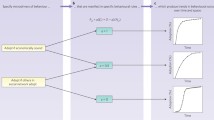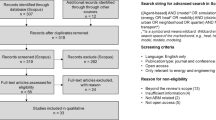Abstract
This paper presents a methodology to cascade probabilistic models and agent-based models for fine-grained data simulation, which improves the accuracy of the results and flexibility to study the effect of detailed parameters. The methodology is applied on residential energy consumption behaviour, where an agent-based model takes advantage of probability distributions used in probabilistic models to generate energy consumption of a house with a focus on energy waste. The implemented model is based on large samples of real data and provides flexibility to study the effect of social parameters on the energy consumption of families. The results of the model highlighted the advantage of the cascading methodology and resulted in two domain-specific conclusions: (1) as the number of occupants increases, the family becomes more efficient, and (2) young, unemployed, and part-time occupants cause less energy waste in small families than full-time and older occupants. General insights on how to target families with energy interventions are included at last.
Access this chapter
Tax calculation will be finalised at checkout
Purchases are for personal use only
Similar content being viewed by others
References
International Energy Agency: Transition to Sustainable Buildings: Strategies and Opportunities to 2050. Technical report (2013). https://www.iea.org/publications/freepublications/publication/Building2013_free.pdf. Accessed 1 Feb 2018
Masoso, O.T., Grobler, L.J.: The dark side of occupants’ behaviour on building energy use. Energy Build. 42, 173–177 (2010)
Aerts, D., Minnen, J., Glorieux, I., Wouters, I., Descamps, F.: A method for the identification and modelling of realistic domestic occupancy sequences for building energy demand simulations and peer comparison. Build. Environ. 75, 67–78 (2014)
Aerts, D.: Simulations, occupancy and activity modelling for building energy demand, comparative feedback and residential electricity demand characteristics. Ph.d. thesis, Vrije University Brussel (2015)
Richardson, I., Thomson, M., Infield, D., Clifford, C.: Domestic electricity use: a high-resolution energy demand model. Energy Build. 42, 1878–1887 (2010)
Zhang, T., Siebers, P.O., Aickelin, U.: A three-dimensional model of residential energy consumer archetypes for local energy policy design in the UK. Energy Policy 47, 102–110 (2012)
Zhang, T., Siebers, P.O., Aickelin, U.: Simulating user learning in authoritative technology adoption: an agent based model for council-led smart meter deployment planning in the UK. Technol. Forecast. Soc. Chang. 106, 74–84 (2016)
Chen, J., Taylor, J.E., Wei, H.H.: Modeling building occupant network energy consumption decision-making: the interplay between network structure and conservation. Energy Build. 47, 515–524 (2012)
Bonabeau, E.: Agent-based modeling: methods and techniques for simulating human systems. Proc. Nat. Acad. Sci. 99(Suppl. 3), 7280–7287 (2002)
Carmenate, T., Inyim, P., Pachekar, N., Chauhan, G., Bobadillaa, L., Batoulib, M., Mostafavi, A.: Modeling occupant-building-appliance interaction for energy waste analysis. Procedia Eng. 145, 42–49 (2016)
Abdallah, F., Basurra, S., Gaber, M.M.: A hybrid agent-based and probabilistic model for fine-grained behavioural energy waste simulation. In: IEEE 29th International Conference on Tools with Artificial Intelligence (ICTAI), pp. 991–995. IEEE (2017)
Widén, J., Andreas, M., Ellegårdc, K.: Models of domestic occupancy, activities and energy use based on time-use data: deterministic and stochastic approaches. J. Build. Perform. Simul. 5(1), 27–44 (2012)
Wilke, U., Haldi, F., Robinson, D.: A bottom-up stochastic model to predict building occupants’ time-dependent activities. Build. Environ. 60, 254–264 (2013)
Reynaud, Q., Haradji, Y., Sempé, F., Sabouret, N.: Using time-use surveys in multi agent based simulations of human activity. In: Proceedings of the 9th International Conference on Agents and Artificial Intelligence, ICAART, Porto, Portugal, vol. 1, pp. 67–77 (2017)
Azar, E., Menassa, C.C.: Framework to evaluate energy-saving potential from occupancy interventions in typical commercial buildings in the united states. J. Comput. Civil Eng. 28(1), 63–78 (2014)
Zhang, T., Siebers, P.O., Aickelin, U.: Modelling electricity consumption in office buildings: an agent based approach. Energy Build. 43, 2882–2892 (2011)
Eurostat: the statistical office of the European Union: Average number of rooms per-person and group by type of household income from 2003 - EU-SILC survey (2003 onwards). https://data.europa.eu/euodp/en/data/dataset/pYzSXuZuS2yZzD3nQKQcWQ. Accessed 3 July 2017
Evans, A.W., Hartwich, O.M.: Unaffordable housing: fables and myths. Technical report, Policy Exchange (2005)
Author information
Authors and Affiliations
Corresponding author
Editor information
Editors and Affiliations
Rights and permissions
Copyright information
© 2018 Springer International Publishing AG, part of Springer Nature
About this paper
Cite this paper
Abdallah, F., Basurra, S., Gaber, M.M. (2018). Cascading Probability Distributions in Agent-Based Models: An Application to Behavioural Energy Wastage. In: Rutkowski, L., Scherer, R., Korytkowski, M., Pedrycz, W., Tadeusiewicz, R., Zurada, J. (eds) Artificial Intelligence and Soft Computing. ICAISC 2018. Lecture Notes in Computer Science(), vol 10842. Springer, Cham. https://doi.org/10.1007/978-3-319-91262-2_44
Download citation
DOI: https://doi.org/10.1007/978-3-319-91262-2_44
Published:
Publisher Name: Springer, Cham
Print ISBN: 978-3-319-91261-5
Online ISBN: 978-3-319-91262-2
eBook Packages: Computer ScienceComputer Science (R0)




